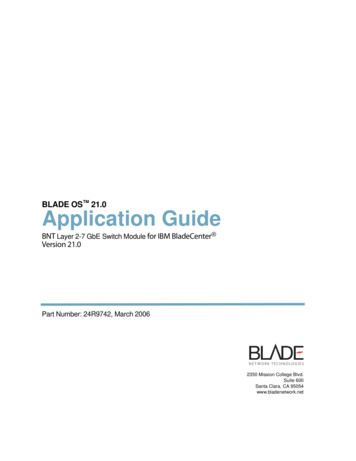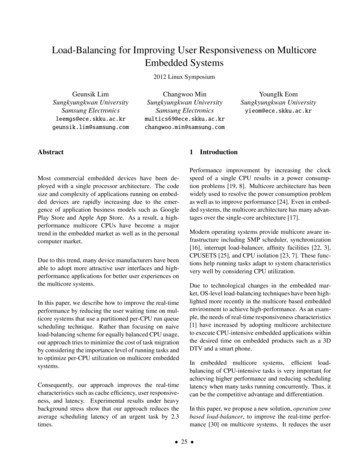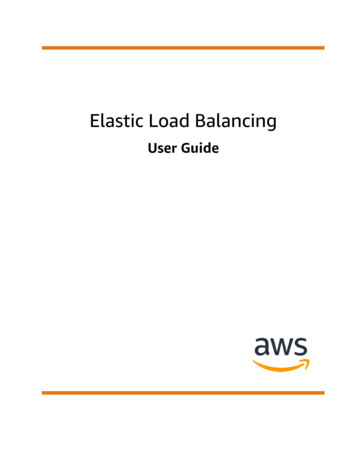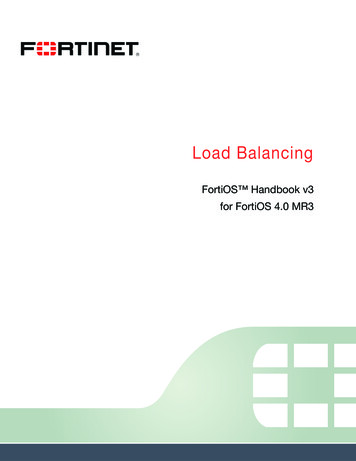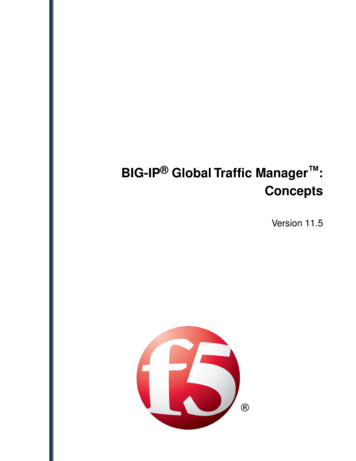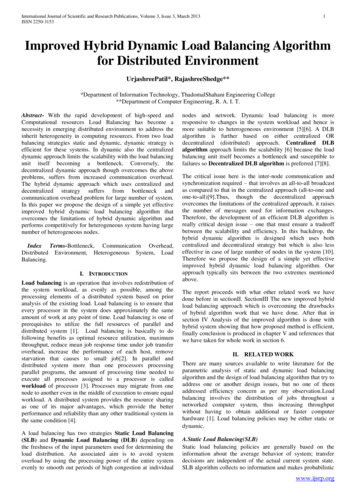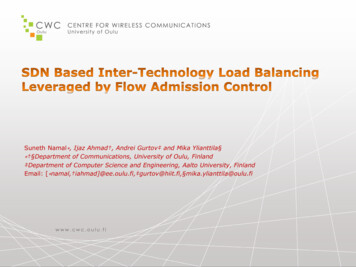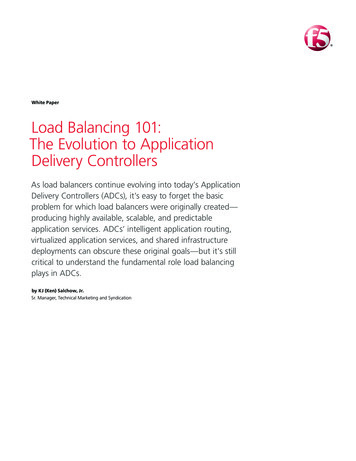
Transcription
White PaperLoad Balancing 101:The Evolution to ApplicationDelivery ControllersAs load balancers continue evolving into today’s ApplicationDelivery Controllers (ADCs), it’s easy to forget the basicproblem for which load balancers were originally created—producing highly available, scalable, and predictableapplication services. ADCs’ intelligent application routing,virtualized application services, and shared infrastructuredeployments can obscure these original goals—but it’s stillcritical to understand the fundamental role load balancingplays in ADCs.by KJ (Ken) Salchow, Jr.Sr. Manager, Technical Marketing and Syndication
White PaperLoad Balancing 101: The Evolution to Application Delivery ControllersContentsIntroduction3Load Balancing Drivers3Load Balancing: A Historical Perspective4In the Beginning, There Was DNS4Proprietary Load Balancing in Software6Network-Based Load balancing Hardware8Application Delivery Controllers10The Future of ADCs112
White PaperLoad Balancing 101: The Evolution to Application Delivery ControllersIntroductionOne of the unfortunate effects of the continued evolution of the load balancer intotoday’s application delivery controller (ADC) is that it is often too easy to forget thebasic problem for which load balancers were originally created—producing highlyavailable, scalable, and predictable application services. We get too lost in therealm of intelligent application routing, virtualized application services, and sharedinfrastructure deployments to remember that none of these things are possiblewithout a firm basis in basic load balancing technology. So how important is loadbalancing, and how do its effects lead to streamlined application delivery?Load Balancing DriversThe entire intent of load balancing is to create a system that virtualizes the “service”from the physical servers that actually run that service. A more basic definition isto balance the load across a bunch of physical servers and make those serverslook like one great big server to the outside world. There are many reasons to dothis, but the primary drivers can be summarized as “scalability,” “high availability,”and “predictability.”Scalability is the capability of dynamically, or easily, adapting to increased loadwithout impacting existing performance. Service virtualization presented aninteresting opportunity for scalability; if the service, or the point of user contact,was separated from the actual servers, scaling of the application would simplymean adding more servers which would not be visible to the end user.High Availability (HA) is the capability of a site to remain available and accessibleeven during the failure of one or more systems. Service virtualization alsopresented an opportunity for HA; if the point of user contact was separatedfrom the actual servers, the failure of an individual server would not render theentire application unavailable.Predictability is a little less clear as it represents pieces of HA as well as somelessons learned along the way. However, predictability can best be described as thecapability of having confidence and control in how the services are being deliveredand when they are being delivered in regards to availability, performance, and so on.3
White PaperLoad Balancing 101: The Evolution to Application Delivery ControllersLoad Balancing:A Historical PerspectiveBack in the early days of the commercial Internet, many would-be dot-commillionaires discovered a serious problem in their plans. Mainframes didn’t haveweb server software (not until the AS/400e, anyway) and even if they did,they couldn’t afford them on their start-up budgets. What they could affordwas standard, off-the-shelf server hardware from one of the ubiquitous PCmanufacturers. The problem for most of them? There was no way that asingle PC-based server was ever going to handle the amount of traffic theiridea would generate and if it went down, they were offline and out of business.Fortunately, some of those folks actually had plans to make their millions bysolving that particular problem; thus was born the load balancing market.In the Beginning, There Was DNSBefore there were any commercially available, purpose-built load balancing devices,there were many attempts to utilize existing technology to achieve the goals ofscalability and HA. The most prevalent, and still used, technology was DNS roundrobin. Domain name system (DNS) is the service that translates human-readablenames (www.example.com) into machine recognized IP addresses. DNS alsoprovided a way in which each request for name resolution could be answeredwith multiple IP addresses in different order.DNS ServerFirst Responsewww.example.com192.0.2.11192.0.2.12Second .11:80ClientInternet192.0.2.12:80Web ClusterFigure 1: Basic DNS response for redundancy4
White PaperLoad Balancing 101: The Evolution to Application Delivery ControllersThe first time a user requested resolution for www.example.com, the DNSserver would hand back multiple addresses (one for each server that hosted theapplication) in order, say 1, 2, and 3. The next time, the DNS server would giveback the same addresses, but this time as 2, 3, and 1. This solution was simple andprovided the basic characteristics of what customer were looking for by distributingusers sequentially across multiple physical machines using the name as thevirtualization point.From a scalability standpoint, this solution worked remarkable well; probably thereason why derivatives of this method are still in use today particularly in regards toglobal load balancing or the distribution of load to different service points aroundthe world. As the service needed to grow, all the business owner needed to do wasadd a new server, include its IP address in the DNS records, and voila, increasedcapacity. One note, however, is that DNS responses do have a maximum length thatis typically allowed, so there is a potential to outgrow or scale beyond this solution.This solution did little to improve HA. First off, DNS has no capability of knowingif the servers listed are actually working or not, so if a server became unavailableand a user tried to access it before the DNS administrators knew of the failure andremoved it from the DNS list, they might get an IP address for a server that didn’twork. In addition, clients tend to cache, or remember, name resolutions. This meansthat they don’t always ask for a new IP address and simply go back to the serverthey used before—regardless of whether it is working and irrespective of theintention to virtualize and distribute load.This solution also highlighted several additional needs in the arena of load balancing.As mentioned above, it became clear that any load balancing device needed thecapability to automatically detect a physical server that had malfunctioned anddynamically remove it from the possible list of servers given to clients. Similarly,any good mechanism must be able to ensure that a client could not bypass loadbalancing due to caching or other means unless there was a good reason for it.More importantly, issues with intermediate DNS servers (which not only cached theoriginal DNS entries but would themselves reorder the list of IPs before handingthem out to clients) highlighted a striking difference between “load distribution”and “load balancing;” DNS round-robin provides uncontrolled distribution, but verypoor balancing. Lastly, a new driver became apparent—predictability.Predictability, if you remember, is the capability of having a high-level of confidencethat you could know (or predict) to which server a user was going to be sent. While5
White PaperLoad Balancing 101: The Evolution to Application Delivery Controllersthis relates to load balancing as compared to uncontrolled load distribution, itcentered more on the idea of persistence. Persistence is the concept of making surethat a user doesn’t get load balanced to a new server once a session has begun,or when the user resumes a previously suspended session. This is a very importantissue that DNS round-robin has no capability of solving.Proprietary Load Balancing in SoftwareOne of the first purpose-built solutions to the load balancing problem was thedevelopment of load balancing capabilities built directly into the applicationsoftware or the operating system (OS) of the application server. While there wereas many different implementations as there were companies who developed them,most of the solutions revolved around basic network trickery. For example, one suchsolution had all of the servers in a cluster listen to a “cluster IP” in addition to theirown physical IP address.RequestConnect to 192.0.2.1Cluster IP:192.0.2.1Physical IP:192.0.2.11:80Client192.18.0.1InternetCluster IP:192.0.2.1Physical IP:192.0.2.12:80ResponseGo to192.0.2.12Web ClusterFigure 2: Proprietary cluster IP load balancingWhen the user attempted to connect to the service, they connected to the cluster IPinstead of to the physical IP of the server. Whichever server in the cluster respondedto the connection request first would redirect them to a physical IP address (eithertheir own or another system in the cluster) and the service session would start.One of the key benefits of this solution is that the application developers could usea variety of information to determine which physical IP address the client shouldconnect to. For instance, they could have each server in the cluster maintain a countof how many sessions each clustered member was already servicing and have anynew requests directed to the least utilized server.Initially, the scalability of this solution was readily apparent. All you had to dowas build a new server, add it to the cluster, and you grew the capacity of your6
White PaperLoad Balancing 101: The Evolution to Application Delivery Controllersapplication. Over time, however, the scalability of application-based load balancingcame into question. Because the clustered members needed to stay in constantcontact with each other concerning who the next connection should go to, thenetwork traffic between the clustered members increased exponentially with eachnew server added to the cluster. After the cluster grew to a certain size (usually5–10 hosts), this traffic began to impact end-user traffic as well as the processorutilization of the servers themselves. So, the scalability was great as long as youdidn’t need to exceed a small number of servers (incidentally, less than DNSround-robin could do).HA was dramatically increased with these solutions. Because the clustered memberswere in constant communication with each other, and because the applicationdevelopers could use their extensive application knowledge to know when aserver was running correctly, this virtually eliminated the chance that a user wouldever reach a server that was unable to service their request. It must be pointedout, however, that each iteration of intelligence-enabling HA characteristics had acorresponding server and network utilization impact, further limiting scalability. Theother negative HA impact was in the realm of reliability. Many of the network tricksused to distribute traffic in these systems were complex and required considerablenetwork-level monitoring; accordingly, they often encountered issues which affectedthe entire application and all traffic on the application network.Predictability was also enhanced by these solutions. Since the application designersknew when and why users needed to be returned to the same server instead ofbeing load balanced, they were able to embed logic that helped to ensure thatusers would stay persistent as long as needed. They also used the same “clustering”technology to replicate user state information between servers, eliminating manyof the instances that required persistence in the first place. Lastly, because of theirdeep application knowledge, they were better able to develop load balancingalgorithms based on the true health of the application instead of things likeconnections, which were not always a good indication of server load.Besides the potential limitations on true scalability and issues with reliability,proprietary application-based load balancing also had one additional drawback—it was reliant on the application vendor to develop and maintain. The primary issuehere is that not all applications provided load balancing, or clustering, technologyand those that did often did not work with those provided by other applicationvendors. While there were several organizations that produced vendor-neutral,OS-level load balancing software, they unfortunately suffered from the same7
White PaperLoad Balancing 101: The Evolution to Application Delivery Controllersscalability issues. And without tight integration with the applications, these software“solutions” also experienced additional HA challenges.Network-Based Load balancing HardwareThe second iteration of purpose-built load balancing came about as network-basedappliances. These are the true founding fathers of today’s Application DeliveryControllers. Because these boxes were application-neutral and resided outside ofthe application servers themselves, they could achieve their load balancing usingmuch more straight-forward network techniques. In essence, these devices wouldpresent a virtual server address to the outside world and when users attempted toconnect, it would forward the connection on the most appropriate real server doingbi-directional network address translation (NAT).172.16.1.1:80BIG-IPLocal Traffic ManagerPhysical Server172.16.1.11:80ClientInternetBIG-IPLocal Traffic ManagerPhysical Server172.16.1.12:80Web ClusterVirtual Server192.0.2.1:80Figure 3: Load balancing with network-based hardwareThe load balancer could control exactly which server received which connectionand employed “health monitors” of increasing complexity to ensure that theapplication server (a real, physical server) was responding as needed; if not,it would automatically stop sending traffic to that server until it produced thedesired response (indicating that the server was functioning properly). Althoughthe health monitors were rarely as comprehensive as the ones built by theapplication developers themselves, the network-based hardware approach couldprovide at least basic load balancing services to nearly every application in auniform, consistent manner—finally creating a truly virtualized service entry pointunique to the application servers serving it.Scalability with this solution was only limited by the throughput of the loadbalancing equipment and the networks attached to it. Health monitoring, while still8
White PaperLoad Balancing 101: The Evolution to Application Delivery Controllerspotentially impacting the network, no longer grew exponentially because only theload balancer needed to maintain health information on the entire cluster, not eachserver. This reduced the overhead costs on the network and the servers providingadditional headroom. It was not uncommon for organization replacing softwarebased load balancing with a hardware-based solution to see a dramatic drop inthe utilization of their servers preventing them from having to purchase additionalservers in the short-term and generating increased ROI in the long-term.HA was also dramatically reinforced with a hardware-based solution. Granted, itdid require these systems to be deployed as HA pairs to provide for their own faulttolerance, but simply reducing the complexity of the solution as well as providingapplication-impartial load balancing provided greater reliability and increased depthas a solution. Network-based load balancing hardware enabled the business ownerto provide the high-levels of availability to all their applications instead of merely theselect few with built-in load balancing.Predictability was a core component added by the network-based load balancinghardware. Because the load balancing decisions were all deterministic (consistingof real-world measurements of connection load, response times, and so on) asopposed to the synthetic approach of most application-based solutions, it wasmuch easier to predict where a new connection would be directed and mucheasier to manipulate. These devices were also capable of giving real-world usageand utilization statistics which provided insight for the capacity planning team andhelped to document the results of load balancing operations. Interestingly enough,this solution reintroduced the positive potential of load distribution versus loadbalancing. Load balancing is an ideal goal if all your servers are identical; however,as a site grows and matures, that is often not the case. The added intelligence tocreate controlled load distribution (as opposed to the uncontrolled distribution ofdynamic DNS) allowed business owners to finally use load distribution in a positiveway, sending more connections to the bigger server and less to the smaller one.The advent of the network-based load balancer ushered in a whole new era in thearchitecture of applications. HA discussions that once revolved around “uptime”quickly became arguments about the meaning of “available” (if a user has to wait30 seconds for a response, is it available? What about one minute?). They alsobrought about new benefits for security and management like masking the trueidentity of application servers from the Internet community and providing the abilityto “bleed” connections off of a server so it could be taken offline for maintenancewithout impacting users. This is the basis from which Application DeliveryControllers (ADCs) originated.9
White PaperLoad Balancing 101: The Evolution to Application Delivery ControllersApplication Delivery ControllersSimply put, ADCs are what all good load balancers grew up to be. While mostADC conversations rarely mention load balancing, without the capabilities of thenetwork-based hardware load balancer, they would be unable to affect applicationdelivery at all. Today, we talk about security, availability, and performance, but theunderlying load balancing technology is critical to the execution of all.When discussing ADC security, the virtualization created by the base load balancertechnology is absolutely critical. Whether we discuss SSL/TLS encryption offload,centralized authentication, or even application-fluent firewalls, the power of thesesolutions lies in the fact that a hardware load balancer is the aggregate point ofvirtualization across all applications. Centralized authentication is a classic example.Traditional authentication and authorization mechanisms have always been builtdirectly into the application itself. Similar to the application-based load balancing,each implementation was dependent on, and unique to, each application’simplementation resulting in numerous and different methods. Instead, by applyingauthentication at the virtualized entry point to all applications, a single, uniformmethod of authentication can be applied. Not only does this drastically simplifythe design and management of the authentication system, it also improves theperformance of the application servers themselves by eliminating the need toperform that function. Furthermore, it also eliminates the need, especially inhome-grown applications, to spend the time and money to develop authenticationprocesses in each separate application.Availability is the easiest ADC attribute to tie back to the original load balanceras it relates to all of the basic load balancer attributes: scalability, high availability,and predictability. However, ADCs take this even further than the load balancerdid. Availability for ADCs also represents advanced concepts like applicationdependency and dynamic provisioning. ADCs are capable of understanding thatin today’s world, applications rarely operate in a self-contained manner; theyoften rely on other applications in order to fulfill their design. This knowledgeincreases the ADC’s capability to provide application availability by taking theseother processes into account as well. The most intelligent ADCs on the market alsoprovide programmatic interfaces that allow them to dynamically change the waythey provide services based on external input. These interfaces enable such things asdynamic provisioning and the addition and/or subtraction of available servers basedon utilization and need.10
White PaperLoad Balancing 101: The Evolution to Application Delivery ControllersPerformance enhancement was another obvious extension to the load balancingconcept. Load balancers inherently improved performance of applications byensuring that connections where not only distributed to services that were available(and responding in an acceptable timeframe), but also to the services with the leastamount of connections and/or processor utilization. This made sure that each newconnection was being serviced by the system that was best able to handle it. Later,as SSL/TLS offload (using dedicated hardware) became a common staple of loadbalancing offerings, it reduced the amount of computational overhead of encryptedtraffic as well as the load on back-end servers—improving their performance as well.Today’s ADCs, however, go even further. These devices often include caching,compression, and even rate-shaping technology to further increase the overallperformance and delivery of applications. In addition, rather than being the staticimplementations of traditional stand-alone appliances providing these services, anADC can use its innate application intelligence to only apply these services whenthey will yield a performance benefit—thereby optimizing their use. For instance,compression technology—despite the common belief—is not necessarily beneficialto all users of the application. Certainly, users with small bandwidth (like dial-upor mobile packet-data) can benefit tremendously from smaller packets since thebottleneck is actual throughput. Even connections that must traverse long distancescan benefit as smaller packets mean less round-trips to transport data decreasingthe impact of network latency. However, short-distance connections (say, withinthe same continent) with large bandwidth (broadband cable/DSL) actually takea performance hit in applying compression; since throughput is not necessarilythe bottleneck, the additional overhead of compression and decompression addslatency that the increased throughput does not make up for from a performanceperspective. In other words, if not properly managed, compression technology asa solution can be worse than the original problem. But by intelligently applyingcompression only when it will benefit overall performance, an ADC optimizes theuse and cost of compression technology, leaving more processor cycles for functionsthat will get the most use out of them.The Future of ADCsADCs are the natural evolution to the critical network real estate that load balancersof the past held, and while they owe a great deal to those bygone devices, they area distinctly new breed providing not just availability, but performance and security.As their name suggests, they are concerned with all aspects of delivering anapplication in the best way possible.11
White PaperLoad Balancing 101: The Evolution to Application Delivery ControllersJust as load balancers evolved to become ADCs, the ever-changing needs of thetechnical world will continue to mold and shape ADCs into something even morecapable of adapting to the availability, performance, and security requirements ofapplication delivery. Ideas of integrating Network Access Control (generic NAC),new ideas in application caching/compression, and even the increasing importanceof applying business rules to the management and control of application deliverywill continue to stretch the boundaries of the benefits that these devices can offeran organization. The increasing pressure to consolidate and minimize the numberof devices in the network between the user and the application will continue tocollapse traditional stand-alone technologies (like firewalls, anti-virus, and IPS) intothe realm of the ADC. As new technologies and protocols are developed in anattempt to satiate the increasing desire for on-anywhere, from-anywhere access toapplications and data, the ADCs of tomorrow will likely provide the intelligence todetermine how these (and other) technologies will be integrated into the existingnetwork, as well as where and when they’d be most effective.While it remains unclear exactly how many technologies will be directly replaced byADC delivered components, it is clear that ADCs will evolve into the primary conduitand integration point through which these integrated technologies interface withthe applications being delivered and the users who use them.F5 Networks, Inc. 401 Elliott Avenue West, Seattle, WA 98119F5 Networks, Inc.Corporate Headquartersinfo@f5.comF5 NetworksAsia-Pacificapacinfo@f5.com888-882-4447F5 Networks .comF5 NetworksJapan K.K.f5j-info@f5.com 2012 F5 Networks, Inc. All rights reserved. F5, F5 Networks, the F5 logo, and IT agility. Your way., are trademarks of F5 Networks, Inc. in the U.S. and in certain other countries. Other F5 trademarks are identifiedat f5.com. Any other products, services, or company names referenced herein may be trademarks of their respective owners with no endorsement or affiliation, express or implied, claimed by F5. CS01-00095 0412
issue that DNS round-robin has no capability of solving. Proprietary Load Balancing in Software One of the first purpose-built solutions to the load balancing problem was the development of load balancing capabilities built directly into the application software or the operating system (OS) of the application server. While there were


